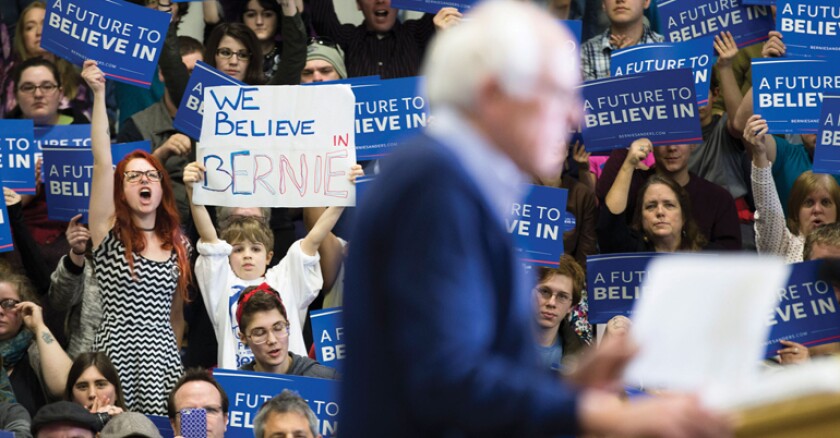Bernie Sanders campaigned hard on these themes in the early stages of his presidential bid, and they paid off handsomely for him. In Iowa, his promise of free college education helped him win 84 percent of the millennial vote, compared with 14 percent for Hillary Clinton. The gambit was especially important because many of the millennials who helped put Barack Obama into the White House had been drifting toward the Republicans. Not to be left on the sidelines, Clinton announced her own higher education plan. Both are working hard to capture this big middle-class issue.
College debt is a quiet policy crisis that’s starting to bubble over. At the height of the Great Recession in 2009, according to the New York Federal Reserve, nationwide debt for homeowner lines of credit, auto loans, credit cards and student loans were all in the same ballpark, between $700 billion and $800 billion. Since then, homeowner and credit card debt have trended down. Car loans are up, but that’s a good sign: Families can afford to buy cars. Student debt is the problem. It has soared to more than $1.2 trillion.
The number of student borrowers is smaller than it was before the Great Recession, but loan balances and delinquencies have increased. Since the depths of the recession, consumers have been paying down their homeowner lines of credit, credit card debt and car loans, but have increasingly defaulted on their student loans. Some 17 percent of student borrowers, nearly 1 in 5, are in default or are delinquent.
Perhaps even more worrisome, the problem is growing in middle-class households. For people who left school in 2005, the default and delinquency rate five years later for those making between $40,000 and $60,000 was about 30 percent. That number rose to nearly 40 percent for students who graduated in 2009.
The issue is politically explosive. Rising debt, default and delinquency risk crippling the dreams of parents hoping to help their kids get a toehold in the 21st-century economy. Kids are being saddled with damaged credit that will make it harder for them to buy a car, purchase a home or pass background checks for a job. The debt problem is certainly shaping the decisions students make about what to study and what careers to pursue. At a time when boomerang kids are already moving back to their parents’ basements -- and when so many families are struggling to stabilize themselves and their savings after the beating they took during the recession -- the student loan issue has become one of the biggest worries of middle-class voters.
For the presidential candidates, though, it’s a tough issue to crack. The problem is largely the product of family borrowing, the rising cost of universities and a federal loan program that sits off-budget, apart from regular appropriations. Sanders promised free tuition at public colleges and universities, but the states would have to pay a third of the cost of his plan, to the tune of $23 billion a year. Clinton has countered by pledging “debt-free tuition” at public colleges and a major investment in historically black colleges. That would mean more tuition grants, income-contingent repayment plans, more student work during college years and more contributions from higher-income families. States would have to contribute as well, but only about half as much as under the Sanders plan.
The Republican candidates have sensed the problem but haven’t made as many proposals. Early in his campaign, Marco Rubio favored contingent loan programs, in which students’ payments would depend on their future income. He also called for more transparency regarding the jobs students get after completing different programs at different universities. Many Republicans have talked about forcing colleges to rein in the cost of tuition, and in one debate Rubio questioned whether college was worth it, arguing (wrongly) that “welders make more money than philosophers.”
Democrats believe that they can exploit voter impressions that Republicans are sidestepping a basic pocketbook issue important to millions of Americans, and that they can use Greenberg’s strategy to win over those voters. To make the plan work, however, they will need help from the states, both to bring down the cost of college tuition and to fund a big piece of their national plan. Some analysts are wondering whether the Democrats are writing checks the states won’t cash, particularly whether GOP governors would even bother finding the dollars necessary to fund the plan of a new Democratic president.
This issue is only going to get hotter, since the debt load is growing and it affects so many middle-class families. Both sides are raising the stakes on a problem that neither really has the ability to solve -- because the front lines of the battle are in the states, on turf no president can control.









